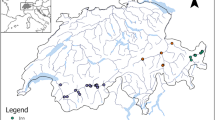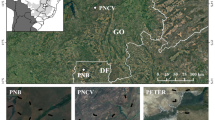Abstract
The species richness of hedges in an agricultural landscape may be determined by the environment and by the spatial processes which occur in that landscape. Here, we divided the environmental predictors into three groups: site conditions, hedge stand and landscape structure. We determined their independent and joint effects on the richness of four guilds of herbaceous species in 92 hedge stands in a north-Mediterranean intensive agricultural landscape. The fine—(at <250 m) and broad—(>550 m) spatial patterns of the key environmental predictors and the pure spatial effects on species richness were measured using a computation of the principal coordinates of a matrix of geographical neighbours integrated into a variation partitioning. The total explained variation of species richness among hedgerows was highest for wetland herbs (62 %), with increasing rates for rare plants (33 %), forest herbs (43 %) and arable weeds (47 %). 43–11 % of that variation was spatially structured and mostly explained by some of the key environmental predictors, such as proportion of a given landuse, presence of woody species and dead trees. This indicates that complex relationships between herbaceous species distribution and spatial processes exist in woody field margins and much of that is related to key factors which are spatially structured, both at fine or broad-scales, with implications for management and landuse planning.



Similar content being viewed by others
References
Andersson TN, Milberg P (1998) Weed flora and the relative importance of site, crop, crop rotation, and nitrogen. Weed Sci 46:30–38
ARPAV (2014) Principali variabili metereologiche. ARPAV, Servizio Informatica e Reti, Padova, Italy. http://www.arpa.veneto.it/. Accessed 18 July 2014
Astorga A, Heino J, Luoto M, Muotka T (2011) Freshwater biodiversity at regional extent: determinants of macroinvertebrate taxonomic richness in headwater streams. Ecography 34:705–713
Barbier S, Gosselin F, Balandier P (2008) Influence of tree species on understory vegetation diversity and mechanisms involved—a critical review for temperate and boreal forests. Forest Ecol Manag 254:1–15
Barr CJ, Gillespie MK (2000) Estimating hedgerow length and pattern characteristics in Great Britain using Countryside Survey data. J Environ Manag 60:23–32
Baudry J, Bunce RGH, Burel F (2000) Hedgerows: an international perspective on their origin, function and management. J Environ Manag 60:7–22
Blanchet FG, Legendre P, Borcard D (2008) Forward selection of explanatory variables. Ecology 89:2623–2632
Borcard D, Legendre P (2002) All-scale spatial analysis of ecological data by means of principal coordinates of neighbour matrices. Ecol Model 153:51–68
Borcard D, Legendre P, Drapeau P (1992) Partialling out the spatial component of ecological variation. Ecology 73:1045–1055
Borcard D, Legendre P, Avois-Jacquet C, Tuomisto H (2004) Dissecting the spatial structure of ecological data at multiple scales. Ecology 85:1826–1832
Boutin C, Benoîn J (1998) Intensity of agricultural practises and effects on adjacent habitats. Ecol Appl 8:544–557
Boutin C, Jobin B, Belanger L, Choiniere L (2001) Comparing weed composition in natural and planted hedgerows and in herbaceous field margins adjacent to crop fields. Can J Plant Sci 81:313–324
Bracco F, Marchiori S (2002) Floristic and vegetational aspects. In: Ruffo S (ed) Woodlands of the Po Plain—a fragmented labyrinth. Museo Friulano di Storia Naturale, Udine, pp 17–49
Braun-Blanquet J (1928) Pflanzensoziologie. Grundzüge der Vegetationskunde. Springer, Berlin
de Blois S, Domon G, Bouchard A (2002) Factors affecting plant species distribution in hedgerows of southern Quebec. Biol Conserv 105:355–367
De Caceres M, Legendre P (2009) Associations between species and groups of sites: indices and statistical inference. Ecology 90:3566–3574
Deckers B, Hermy M, Muys B (2004a) Factors affecting plant species composition of hedgerows: relative importance and hierarchy. Acta Oecol 26:23–37
Deckers B, Verheyen K, Hermy M, Muys B (2004b) Differential environmental response of plant functional types in hedgerow habitats. Basic Appl Ecol 5:551–566
Development Core Team R (2010) R: a language and environment for statistical computing. R Foundation for Statistical Computing, Wien
Devlaeminck R, Bossuyt B, Hermy M (2005) Seed dispersal from a forest into adjacent cropland. Agric Ecosyst Environ 107:57–64
Diekmann M (2003) Species indicator values as an important tool in applied plant ecology—a review. Basic Appl Ecol 6:493–506
Dixon PM, Weiner J, Mitchell-Olds T, Woodley R (1988) Erratum to ‘Bootstrapping the Gini coefficient of inequality’. Ecology 69:1307
Dormann CF, Elith J, Bacher S, Buchmann C, Carl G, Carré G, Marquéz JRG, Gruber B, Lafourcade B, Leitão PJ, Münkemüller T, McClean C, Osborne PE, Reineking B, Schröder B, Skidmore AK, Zurell D, Lautenbach S (2013) Collinearity: a review of methods to deal with it and a simulation study evaluating their performance. Ecography 36:27–46
Dray S, Legendre P, Blanchet FG (2007) Packfor: R package for forward selection with permutation, Version 0.0-7
Dray S, Legendre P, Peres-Neto PR (2006) Spatial modelling: a comprehensive framework for principal coordinate analysis of neighbour matrices (PCNM). Ecol Model 196:483–493
Dufrêne M, Legendre P (1997) Species assemblages and indicator species: the need for a flexible asymmetrical approach. Environ Monogr 67:345–366
Ellenberg H, Weber HE, Düll R, Wirth V, Werner W (1992) Zeigerwerte von Pflanzen in Mitteleuropa. Scr Geobot 18:1–258
Forman RTT, Baudry J (1984) Hedgerows and hedgerow networks in landscape ecology. Environ Manag 8:495–510
Gabriel D, Thies C, Tscharntke T (2005) Local diversity of arable weeds increases with landscape complexity. Perspect Plant Ecol 7:85–93
Guilhaumon F, Kindt R, Legendre P, O’Hara RB, Stevens MHH (2010) mmSAR: an R-package for multimodel species–area relationship inference. Ecography 33:420–424
Hernández-Stefanoni JL, Dupuy JM, Tun-Dzul F, May-Pat F (2011) Influence of landscape structure and stand age on species density and biomass of a tropical dry forest across spatial scales. Landscape Ecol 26:355–370
Hodgson JA, Moilanen A, Wintle BA, Thomas CD (2011) Habitat area, quality and connectivity: striking the balance for efficient conservation. J Appl Ecol 48:148–152
Kalkhan MA (2011) Spatial statistics: geospatial information modeling and thematic mapping. CRC Press, New York
Keddy PA (1992) Assembly and response rules: two goals for predictive community ecology. J Veg Sci 3:157–164
Kleijn D, Verbeek M (2000) Factors affecting the species composition of arable field boundary vegetation. J Appl Ecol 37:256–266
Laliberté E, Paquette A, Legendre P, Bouchard A (2009) Assessing the scale-specific importance of niches and other spatial processes on beta diversity: a case study from a temperate forest. Oecologia 159:377–388
Laliberté E, Norton DA, Tylianakis JM, Scott D (2010) Comparison of two sampling methods for quantifying changes in vegetation composition under rangeland development. Rangeland Ecol Manag 63:537–545
Latham PA, Zuuring HR, Coble DW (1998) A method for quantifying vertical forest structure. Forest Ecol Manag 104:157–170
Legendre P (1993) Spatial autocorrelation: trouble or new paradigm? Ecology 74:1659–1673
Legendre P, Borcard D, Blanchet G (2010) PCNM: PCNM spatial eigenfunction and principal coordinate analyses. R package
Lindborg R, Eriksson O (2004) Historical landscape connectivity affects present plant species diversity. Ecology 85:1840–1845
Marshall EJP, Moonen AC (2002) Field margins in northern Europe: their functions and interactions with agriculture. Agric Ecosyst Environ 89:5–21
Meeus JHA, Wijermans MP, Vroom MJ (1990) Agricultural landscapes in Europe and their transformation. Landscape Urban Plan 18:289–352
Metzger MJ, Bunce RGH, Jongman RHG, Mücher CA, Watkins JW (2005) A climatic stratification of the environment of Europe. Global Ecol Biogeogr 14:549–563
Milsom TP, Sherwood AJ, Rose SC, Town SJ, Runham SR (2004) Dynamics and management of plant communities in ditches bordering arable fenland in eastern England. Agric Ecosyst Environ 103:85–99
Oksanen J, Kindt R, Legendre P, O’Hara RB, Stevens MHH (2008) Vegan: community ecology package. R package version 1.15-1
Olson DM, Wackers FL (2007) Management of field margins to maximise multiple ecological services. J Appl Ecol 44:13–21
Paoletti MG, Lorenzoni GG (1989) Agroecology patterns in northeastern Italy. Agric Ecosyst Environ 27:139–154
Pascual-Hortal L, Saura S (2006) Comparison and development of new graph-based landscape connectivity indices: towards the prioritization of habitat patches and corridors for conservation. Landscape Ecol 21:959–967
Peres-Neto PR, Legendre P (2010) Estimating and controlling for spatial structure in the study of ecological communities. Global Ecol Biogeogr 19:174–184
Provincia di Treviso (2005) Carta dei Suoli del Veneto. Servizio Osservatorio Suoli e Rifiuti—Dipartimento Prov. di Treviso, Treviso
Roy V, de Blois S (2008) Evaluating hedgerow corridors for the conservation of native forest herb diversity. Biol Conserv 141:298–307
Sanchez IA, Lassaletta L, McCollin D, Bunce RGH (2010) The effect of hedgerow loss on microclimate in the Mediterranean region: an investigation in Central Spain. Agroforest Syst 78:13–25
Schmidt M, Ewald J, Fischer A, Oheimb von G, Kriebitzsch W-U, Ellenberg H, Schmidt W (2003) Liste der Waldegefäßpflanzen Deutschlands. Mitt Bundesforsch.anst Forst- Holzwirtsch 212:1–68
Schmucki R, de Blois S (2009) Population structures and individual performances of Trillium grandiflorum in hedgerow and forest habitats. Plant Ecol 202:67–78
Shmida A, Ellner S (1984) Coexistence of plant species with similar niche. Vegetatio 58:29–55
Sitzia T (2007) Hedgerows as corridors for woodland plants: a test on the Po Plain, northern Italy. Plant Ecol 188:235–252
Sitzia T, Trentanovi G (2011) Maggengo meadow patches enclosed by forests in the Italian Alps: evidence of landscape legacy on plant diversity. Biodivers Conserv 20:945–961
Sitzia T, Campagnaro T, Dainese M, Cierjacks A (2012) Plant species diversity in alien black locust stands: a paired comparison with native stands across a north-Mediterranean range expansion. For Ecol Manag 285:85–91
Sitzia T, Trentanovi G, Marini L, Cattaneo D, Semenzato P (2013) Assessment of hedge stand types as determinants of woody species richness in rural field margins. iForest 6:201–208
Sitzia T, Pizzeghello D, Dainese M, Ertani A, Carletti P, Semenzato P, Nardi S, Cattaneo D (2014) Topsoil organic matter properties in contrasted hedgerow vegetation types. Plant Soil. doi:10.1007/s11104-014-2177-7
Tüxen R, Ellenberg H (1937) Der systematische und ökologische Gruppenwert. Ein Beitrag zur Begriffsbildung und Methodik der Pflanzensoziologie. Mitt Florist-soziol Arb.gem 3:171–184
Veneto Regione (2009) Banca Dati della Copertura del Suolo delle Regione Veneto. Regione Veneto. Unità di Progetto per il SIT e la Cartografia, Venezia
Watt TA, Buckley GP (eds) (1995) Hedgerow management and nature conservation. Imperial College Press, London
Willi JC, Mountford JO, Sparks TH (2005) The modification of ancient woodland ground flora at arable edges. Biodivers Conserv 14:3215–3233
Winqvist C, Bengtsson J, Aavik T, Berendse F, Clement LW, Eggers S, Fischer C, Flohre A, Geiger F, Liira J, Pärt T, Thies C, Tscharntke T, Weisser WW, Bommarco R (2011) Mixed effects of organic farming and landscape complexity on farmland biodiversity and biological control potential across Europe. J Appl Ecol 48:570–579
Zanaboni A, Lorenzoni GG (1989) The importance of relict vegetation and hedges in the agroecosystems and environment reconstruction. Agric Ecosyst Environ 27:155–161
Zelený D, Schaffers AP (2012) Too good to be true: pitfalls of using mean Ellenberg indicator values in vegetation analyses. J Veg Sci 23:419–431
Acknowledgments
The authors thank Marie Smolenova, Andrea Rizzi, Davide Cinquino and Alberto Tarabotti for their assistance in collecting the environmental and species data. We also acknowledge the assistance of Filippo Prosser and Roberto Masin in species determination and of Stefano Tasinazzo in grouping the species into arable weeds and rare species. Revisions on the paper were made during two visiting fellowships: to DM, within a 2013 visiting scientist grant by the University of Padova, under TS responsibility, and to TS at Northampton University, within an European Union LLP/Erasmus Teaching Staff bilateral agreement. MD was supported by a postdoctoral research fellowship "Grant" (Dept. TESAF Decree no. 36/ Protocol no. 1006/2011) mentored by TS.
Author information
Authors and Affiliations
Corresponding author
Additional information
Communicated by J. L. Firn.
Electronic supplementary material
Below is the link to the electronic supplementary material.
Rights and permissions
About this article
Cite this article
Sitzia, T., Dainese, M. & McCollin, D. Environmental factors interact with spatial processes to determine herbaceous species richness in woody field margins. Plant Ecol 215, 1323–1335 (2014). https://doi.org/10.1007/s11258-014-0390-3
Received:
Accepted:
Published:
Issue Date:
DOI: https://doi.org/10.1007/s11258-014-0390-3




